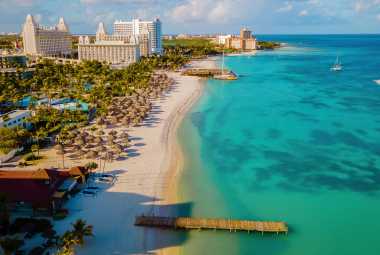Image by kimkim.com
*Vacation Mode is a for-profit site. It contains paid banner advertisements that are generated and managed by a third-party network. This site also includes relevant affiliate links (both in the content and on the sidebar) all of which we do our best to clearly mark as such.
Embarking on a journey to Costa Rica unveils a world of unparalleled natural beauty, adventure, and cultural richness. This Central American gem, known for its lush rainforests, stunning beaches, diverse wildlife, and friendly locals, offers something for every type of traveler. Whether you're a solo adventurer seeking the thrill of zip-lining through cloud forests, a family looking for safe and engaging experiences, or someone simply wanting to relax by the volcanic hot springs, Costa Rica promises an unforgettable escape. From understanding the best travel times and essential packing tips to navigating local customs and exploring the country's must-see destinations, this guide provides a comprehensive overview of what to know before you go. Let's dive into these detailed insights to help you make the most of your Costa Rican adventure.
-
Can I Get Around Costa Rica Without Knowing Spanish? While Spanish is the official language, many Costa Ricans speak English, particularly in tourist areas and among younger generations. Learning basic Spanish phrases can greatly enhance your experience by facilitating interactions with locals and navigating less touristy areas.
-
When is the Best Time to Visit Costa Rica? The dry season from December to April is considered the best time to visit for beach vacations and wildlife spotting, as it offers sunny days and minimal rainfall. However, the green season (May to November) can be appealing for those who prefer fewer crowds and lush landscapes, despite the possibility of afternoon showers.
-
Where is the Best Place to Visit in Costa Rica? Costa Rica boasts diverse attractions; Arenal Volcano for hot springs and hiking, Monteverde Cloud Forest for biodiversity and zip-lining, and Manuel Antonio National Park for stunning beaches and wildlife. Your interests should guide your choice, whether they lean towards adventure, relaxation, or nature.
-
Where Can I See a Volcano in Costa Rica? Arenal and Poás Volcanoes are among the most famous and accessible, offering unique landscapes and activities like hiking and hot springs. Irazú and Turrialba are also notable mentions, each with distinct features and views.
-
What is Rainy Season in Costa Rica Like? During the rainy season, mornings often start sunny, with rains typically in the afternoon. This season brings out the country's lush greenery and can be a great time to visit for those looking to avoid crowds and enjoy lower prices. The Caribbean coast tends to be drier compared to the rest of the country.
-
Is Costa Rica Safe for Solo Female Travelers? Costa Rica is relatively safe for solo female travelers, but it's important to follow standard travel safety tips such as avoiding isolated areas at night, keeping valuables secure, and staying informed about the areas you plan to visit.
-
Is Costa Rica Safe for Families? Yes, it is a fantastic destination for families, offering a variety of activities suitable for all ages, from beach days and wildlife tours to adventure sports. Costa Rica’s emphasis on eco-tourism and education also provides numerous learning opportunities for children.
-
How Much Should I Tip in Costa Rica? Tipping is a way to show appreciation for good service. In restaurants, a 10% service charge is often included, but you can tip extra for exceptional service. For tour guides and drivers, $5-$10 per day is a good guideline, depending on the quality of the service.
-
Does Costa Rica Take USD? USD is widely accepted, especially in tourist areas, but it's good practice to have some Costa Rican colón for smaller purchases or in more rural areas. Always check the exchange rate to ensure you're getting a fair deal.
-
What Do I Need to Pack for Costa Rica? Pack lightweight and breathable clothing for the tropical climate, along with a rain jacket for sudden showers. Sturdy hiking shoes are a must for outdoor activities, and don’t forget sunscreen, insect repellent, and a hat for sun and bug protection. A good camera for capturing wildlife and scenic views is also recommended.
-
What Are the Must Do’s in Costa Rica? Ziplining through cloud forests, soaking in volcanic hot springs, exploring national parks, surfing on both the Pacific and Caribbean coasts, and spotting diverse wildlife are among the must-do experiences in Costa Rica.
-
What Are the Must See’s in Costa Rica? Must-see destinations include the majestic Arenal Volcano, the biodiverse Corcovado National Park, the tranquil Tortuguero National Park known for its turtles, and the unique Monteverde Cloud Forest Reserve.
-
What Voltage Does Costa Rica Use? Costa Rica uses 110 volts, 60 Hz, which is the same as the United States, making it convenient for travelers from the US to charge their electronic devices without needing a converter.
-
Should I Rent a Car or Take Shuttles in Costa Rica? The choice between renting a car and taking shuttles depends on your travel style. Renting a car provides flexibility to explore at your own pace, ideal for adventurous travelers or those visiting remote areas. Shuttles are convenient for direct routes between major destinations and for those who prefer not to navigate Costa Rica’s roads.
-
Do I Need a 4×4 to Drive in Costa Rica? While many tourist destinations are accessible with a standard car, a 4×4 is recommended for remote areas, especially in the rainy season, to navigate rough terrain and unpaved roads safely.
-
What Side of the Road Does Costa Rica Drive On? Costa Rica drives on the right-hand side of the road, consistent with the United States and most European countries, making it easier for travelers from those regions to adapt.
-
How Bad Are the Mosquitoes in Costa Rica? Mosquito presence varies by region and season. Coastal and lowland areas tend to have more mosquitoes, especially during the rainy season. Use insect repellent and wear long sleeves and pants during dawn and dusk to minimize bites.
-
Should I Be Worried About Snakes or Spiders in Costa Rica? While Costa Rica is home to a variety of snakes and spiders, encounters with dangerous species are rare. Staying on marked trails, using a guide in unfamiliar areas, and checking shoes and clothing can minimize risks.
-
Can I Drink the Tap Water in Costa Rica? Tap water is generally safe to drink in major cities and tourist areas, but it's advisable to drink bottled water or purify tap water in rural areas or if you have a sensitive stomach.
-
Can I Flush Toilet Paper in Costa Rica? The plumbing system in many areas isn't designed to handle flushed toilet paper. Look for signs or a waste bin provided for used toilet paper to avoid plumbing issues.
-
How Soon Should I Book Tours in Costa Rica? Booking tours a few weeks in advance is recommended, especially for popular activities like zip-lining, guided wildlife tours, and visits to national parks during peak travel seasons.
-
Where Can I See Sloths in Costa Rica? Sloths can be seen in many parts of Costa Rica, including Manuel Antonio National Park, the Monteverde Cloud Forest, and the Caribbean coast. Guided tours can increase your chances of spotting these elusive creatures.
-
What Is Costa Rican Culture Like? Costa Rican culture is characterized by "Pura Vida" (pure life), reflecting a relaxed, optimistic attitude towards life. It's a culture deeply rooted in family values, environmental conservation, and a love for celebrations and traditions.
-
The Reality of Moving to Costa Rica Moving to Costa Rica can offer a peaceful, nature-centric lifestyle with a lower cost of living than many Western countries. However, potential expats should be prepared for a slower pace of life, cultural adjustments, and navigating the local bureaucracy for residency and services.
-
What Are Some Things Tourists Should Be Careful About in Costa Rica? Tourists should be cautious of petty theft, especially in crowded places and beaches. It's also important to heed warnings about rip currents on beaches and to stay on marked trails to avoid getting lost in nature reserves.
-
What Can I Not Bring into Costa Rica? Prohibited items include drugs, unauthorized firearms, and certain agricultural items to prevent the spread of diseases. It’s best to check the latest customs regulations before traveling.
-
Can You Use Your Cell Phone in Costa Rica? You can use your cell phone in Costa Rica by enabling international roaming, purchasing a local SIM card for your unlocked phone, or using VoIP apps over Wi-Fi.
-
Should You Carry Your Passport With You in Costa Rica? Carrying a photocopy of your passport and leaving the original in a safe place is often advised to avoid losing it while ensuring you have ID on you.
-
Can I Text While in Costa Rica? Yes, through international plans, local SIM cards, or Wi-Fi using messaging apps like WhatsApp or Messenger.
-
Is There Free Wi-Fi in Costa Rica? Many hotels, restaurants, cafes, and public places in Costa Rica offer free Wi-Fi, making it easy to stay connected.
-
How Can I Avoid Roaming Charges in Costa Rica? To avoid high roaming charges, you can turn off cellular data and use Wi-Fi, purchase a local SIM card, or check if your carrier offers an affordable international plan.
-
Should I Carry My Passport or Leave It at the Hotel? It's safer to leave your passport in a secure place like a hotel safe and carry a photocopy for identification purposes when out and about.
-
Is It Safe to Carry a Purse in Costa Rica? Carrying a purse is generally safe, but as in any tourist destination, it's wise to be cautious, particularly in crowded areas. Consider using a travel pouch or money belt for added security.
-
Do You Go Through Customs When Leaving the US to Costa Rica? When traveling from the US to Costa Rica, you'll need to go through customs and immigration upon arrival in Costa Rica to declare any goods and comply with entry requirements.
Conclusion
Costa Rica, a jewel in the heart of Central America, beckons travelers with its lush rainforests, stunning beaches, and abundant wildlife. This paradise offers an array of experiences, from thrilling adventures in the cloud forests to serene moments on its pristine shores. Whether you're planning your first visit or returning to delve deeper into its natural wonders, understanding the nuances of travel, culture, and safety in Costa Rica can transform a good trip into an unforgettable journey. From navigating language barriers to choosing the perfect time to visit, this guide provides essential insights to help you make the most of your Costa Rican adventure. Embrace the pura vida lifestyle and prepare to explore the vibrant landscapes, rich biodiversity, and warm hospitality of this incredible destination.


















